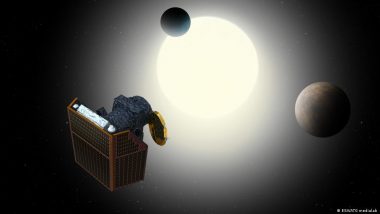The European satellite has revealed the secrets of a planetary system that's puzzled scientists for years. It will teach them about other stars and planets.A European Space Agency exoplanet chaser, Cheops, has unlocked the mystery behind a system of six exoplanets that has bewildered scientists for years.
Also Read | Do Computers Make Children ‘dumber, Not Smarter’?.
Investigators had been looking at a star about 100 light-years away and noticed dips in its brightness that indicated the existence of two planets.
Also Read | Could German Schools Soon Stop Digitization?.
But it was the Cheops (CHaracterising ExOPlanet Satellite) satellite that provided the key data to show there are in fact six planets in the system.
Where is the exoplanetary system?
The star — known as HD110067 — and its orbiting planets are in the northern constellation of Coma Berenices.
Coma Berenices was named after Queen Berenice II of Egypt and means "Berenices Hair". It is home to a number of galaxies.
Legend has it — long story, short — that Berenice cut off her locks to save her husband from dying in battle, and her locks were then placed in the stars.
The constellation is faint, but can be seen with a telescope from Earth.
How did Cheops solve the mystery of the six planets?
It all started in 2020, when NASA's Transiting Exoplanet Survey Satellite (TESS) detected those dips in the star's brightness. Dips in the brightness of a star suggested planets were passing in front of the star.
They looked and found two possible planets. One with a solar orbital of 5.642 days, and the other with an undetermined "orbital period" — the time it takes a planet to fly around its sun or star.
Then in 2022, data from TESS allowed scientists to reevaluate the observation and that led them to see two different possible planets.
"That's when we decided to use Cheops," said Rafael Luque of the University of Chicago. Cheops allowed them to spot a third planet in the system.
And that is when they realized that the three planets were in — what is called — an orbital resonance.
The significance of Cheops' discovery
An orbital resonance is when two or more planets orbit their star in relation to one another, causing their relationship to be affected by gravitational influences. This happens because when planets are in orbital resonance, they cause a gravitational force over each other and influence how they orbit their sun.
Now, in the case of the planets orbiting star HD110067, the outer-most planet takes 20.519 days to orbit, which is extremely close to 1.5 times the orbital period of the next planet with 13.673 days. And that is almost exactly 1.5 times the orbital period of the inner planet, which has an orbital period of 9.114 days.
"Cheops gave us this resonant configuration that allowed us to predict all the other periods. Without that detection from Cheops, it would have been impossible," said Rafael in a press release.
As mentioned above, orbital resonance can be disturbed. So finding this "pristine configuration" makes HD110067 a special discovery, said Rafael: "We think only about one percent of all systems stay in resonance. [This] shows us the pristine configuration of a planetary system that has survived untouched" — untouched for about a billion years.
Edited by: Fred Schwaller
(The above story first appeared on LatestLY on Nov 29, 2023 10:20 PM IST. For more news and updates on politics, world, sports, entertainment and lifestyle, log on to our website latestly.com).













 Quickly
Quickly




















